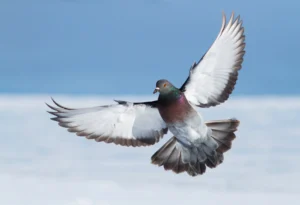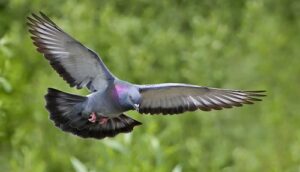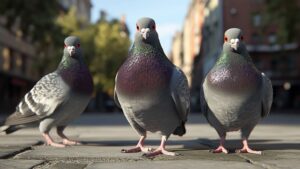Pigeons are some of the most widespread and adaptable birds on the planet. Seen flocking in city squares or gliding through rural skies, they might not seem like the world’s most impressive aviators at first glance. But ask any ornithologist or racing enthusiast, and you’ll find there’s more to these birds than meets the eye. So, how high do pigeons fly?
This article explores the fascinating flight capabilities of pigeons, delving into scientific data, high-flying records, and the factors that influence their aerial performance.
How High Can Pigeons Fly on Average?
On average, pigeons fly at altitudes ranging between 600 to 1,200 feet (183 to 366 meters) above the ground. This typical cruising range allows them to avoid most low-level predators and navigate using both visual landmarks and magnetic fields.
Pigeons are strong and skilled flyers. On average, they fly at heights of up to 6,000 feet (about 1.8 kilometers). In some cases, they can go even higher if they need to. What’s even more impressive is their endurance they can fly for several hours without taking a break, often traveling between 100 to 600 miles in just one trip.
Record-Breaking Heights
While their usual altitude might seem modest, pigeons have been known to soar to much greater heights under the right conditions:
- World Record Flight Height: The highest recorded flight of a pigeon reached an estimated 6,000 feet (1,828 meters).
- Homing pigeons, trained for long-distance racing, often fly between 1,000 and 3,000 feet (305 to 914 meters) to take advantage of favorable wind currents and avoid obstacles.
These remarkable feats are made even more impressive when you consider the pigeon’s relatively small body size and wing structure.
Factors That Affect a Pigeon’s Flying Altitude
Several factors influence how high a pigeon can and will fly:
1. Why Do Pigeons Fly? Understanding the Purpose Behind Their Flight

The height at which pigeons fly often depends on why they’re flying in the first place. Just like people take different routes for short errands versus long road trips, pigeons adjust their flying height based on their goal.
Foraging Flights – Staying Low to the Ground
When pigeons are searching for food, they usually don’t need to go very high. These short trips—known as foraging flights—often happen at lower altitudes. The birds fly closer to rooftops, trees, and open fields where food is easier to spot. Flying low also helps them stay alert for predators and quickly land when they find something to eat.
Migration or Homing Flights – Going Higher and Farther
On the other hand, when pigeons are flying long distances—like returning to their home (a behavior called homing) or moving to a new location—they tend to fly much higher. These longer flights can take them thousands of feet into the sky. Flying at higher altitudes helps pigeons avoid obstacles, stay on course, and take advantage of air currents that make long-distance flying easier and more energy-efficient.
In short, pigeons are smart about how they fly. If it’s just a quick trip for food, they keep it low. But when they’re on a mission to travel far, they soar high into the sky.
2. How Weather and Wind Affect How High Pigeons Fly

Just like people might walk faster or slower depending on the weather, pigeons also adjust how they fly based on the conditions in the sky. Things like wind direction, temperature, and storms all play a big role in how high a pigeon can or will fly.
Tailwinds and Thermals – A Helping Hand from Nature
When the weather is good, pigeons can take advantage of tailwinds—winds that blow in the same direction they’re flying. These winds give them a natural boost, allowing them to fly higher and farther with less effort.
They also make use of thermals, which are rising columns of warm air. Thermals work like invisible elevators in the sky, helping pigeons gain altitude without using much energy. This is especially helpful during long-distance flights, like when pigeons are homing or migrating.
Storms and Headwinds – When the Weather Works Against Them
On the flip side, bad weather can hold pigeons back. Flying through storms, rain, or strong headwinds (winds blowing against their direction) makes it harder to stay airborne and climb to higher altitudes. These conditions can force pigeons to fly lower, change their route, or even pause their journey until the weather clears up.
In short, pigeons are smart fliers that adjust to the sky around them. With the right wind and weather, they can soar high. But when the skies turn rough, they know to stay low or wait it out.
3. The Role of Training and Fitness in How High Pigeons Can Fly

Just like athletes train to run faster or jump higher, pigeons can also improve their flying ability through regular training and conditioning. The difference in how high a pigeon can fly often depends on how well it has been trained and how strong it is.
Trained Racing Pigeons – Built for High Performance
Racing pigeons, also known as homing pigeons, are specially trained birds that take part in races or long-distance flights. These pigeons go through regular training routines, including altitude training, where they practice flying at higher levels. This type of exercise helps them:
- Build stronger flight muscles
- Improve lung capacity and endurance
- Learn how to navigate wind patterns and air currents
Because of their training, racing pigeons can fly higher, longer, and with more control than regular pigeons. Some can travel hundreds of miles in one flight, reaching impressive altitudes along the way.
Wild Pigeons – Flying on Instinct
In comparison, wild pigeons don’t have the same level of training or fitness. They mostly fly out of instinct for food, shelter, or safety. While they are still strong and capable fliers, they may not have the same stamina or experience to fly at high altitudes for long periods. Their flights are often shorter and closer to the ground unless they are escaping a predator or relocating.
Why Training Matters
Training makes a huge difference. Just like a marathon runner can go farther than someone who rarely exercises, trained pigeons are better prepared for high and long-distance flights. So, when it comes to how high pigeons can fly, their level of fitness and experience plays a big role.
4. How the Landscape Affects How High Pigeons Fly

The height at which a pigeon flies often depends on where it lives. Just like people adjust their walking speed based on whether they’re on a city sidewalk or hiking up a mountain trail, pigeons also change their flying habits depending on the environment around them. The landscape—whether it’s full of tall buildings, open countryside, or high mountain ranges—can influence how high pigeons choose or need to fly.
City Pigeons – Navigating the Urban Jungle
Pigeons that live in cities or urban areas often don’t need to fly very high. That’s because they’re usually flying between buildings, rooftops, and other man-made structures. City pigeons are used to:
- Avoiding traffic, people, and tall buildings
- Finding food scraps near streets and parks
- Roosting on ledges, bridges, and rooftops
Since everything they need is relatively close, they typically fly at lower altitudes, often just a few hundred feet above the ground. Flying higher wouldn’t offer much benefit and would take extra energy.
Rural and Mountain Pigeons – Soaring Over Open Space
On the other hand, pigeons living in rural, hilly, or mountainous areas tend to fly much higher. The reason? They need to cover greater distances to find food and may need to fly over trees, hills, and even mountains. In these cases, flying high isn’t just a choice—it’s a necessity.
In open landscapes, pigeons benefit from:
- Wide, open skies with fewer obstacles
- Better visibility for spotting food or predators
- Thermals and air currents that help them fly more efficiently
Some rural pigeons have even been recorded flying at altitudes of several thousand feet, especially when migrating or navigating across large areas.
The Sky Isn’t One-Size-Fits-All
So while urban pigeons fly lower due to buildings, people, and easy access to food, rural or mountain pigeons fly higher to adapt to the natural environment. Each group of pigeons adjusts its flying height to match the world around it, using instincts and experience to stay safe and efficient.
How Do Pigeons Navigate at High Altitudes?
Pigeons possess an extraordinary internal navigation system. They combine magnetic sensing, sun positioning, visual memory, and even olfactory cues to find their way home from hundreds of miles away. At higher altitudes, visual cues become sparse, so pigeons rely more heavily on their magnetic field detection and internal compass.
Comparison with Other Birds
While pigeons are competent flyers, they don’t reach the altitudes of some high-flying species:
| Bird Species | Maximum Recorded Altitude |
|---|---|
| Ruppell’s Vulture | 37,000 feet (11,278 meters) |
| Bar-headed Goose | 29,000 feet (8,839 meters) |
| Whooper Swan | 27,000 feet (8,230 meters) |
| Pigeon (Rock Dove) | 6,000 feet (1,828 meters) |
Real-World Examples and Case Studies
- Racing Competitions: In Belgium and the UK, racing pigeons have been documented flying at altitudes exceeding 2,000 feet, navigating complex terrains and wind patterns.
- Military Use: During World War I and II, messenger pigeons flew across enemy lines, sometimes reaching high altitudes to avoid gunfire.
Why Don’t Pigeons Fly Higher?
Despite their capabilities, pigeons rarely push their altitude limits unless necessary. Flying higher:
- Consumes more energy
- Exposes them to harsher atmospheric conditions
- Offers diminishing returns in terms of visibility and navigation
Tips for Observing Pigeon Flight
If you’re a bird enthusiast or urban explorer, here are some ways to observe pigeon flight behavior:
- Visit city rooftops or high-rise balconies for a better vantage point.
- Use binoculars to track their altitude and flight path.
- Observe early morning or late afternoon for more active flying periods.
Conclusion: How High Do Pigeons Fly?
Pigeons typically fly between 600 and 1,200 feet but are capable of reaching heights up to 6,000 feet under the right conditions. Whether trained for sport, navigating urban landscapes, or traveling long distances, these birds show case surprising agility and endurance in the sky.
Understanding how high do pigeons fly? helps us appreciate their intelligence, adaptability, and the hidden marvels of everyday wildlife. Want to learn more about bird behavior or racing pigeon training? Check out our related articles below!

